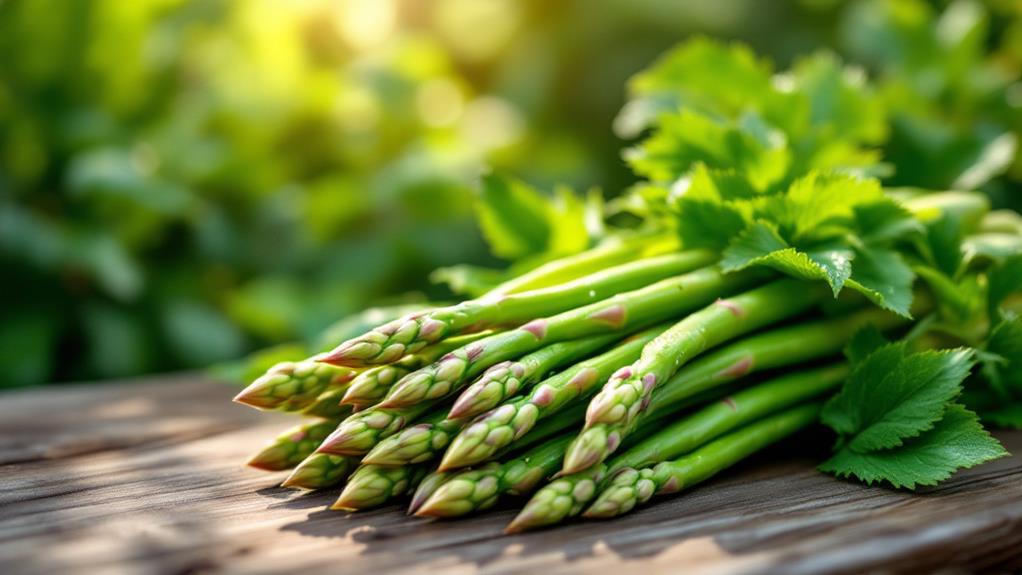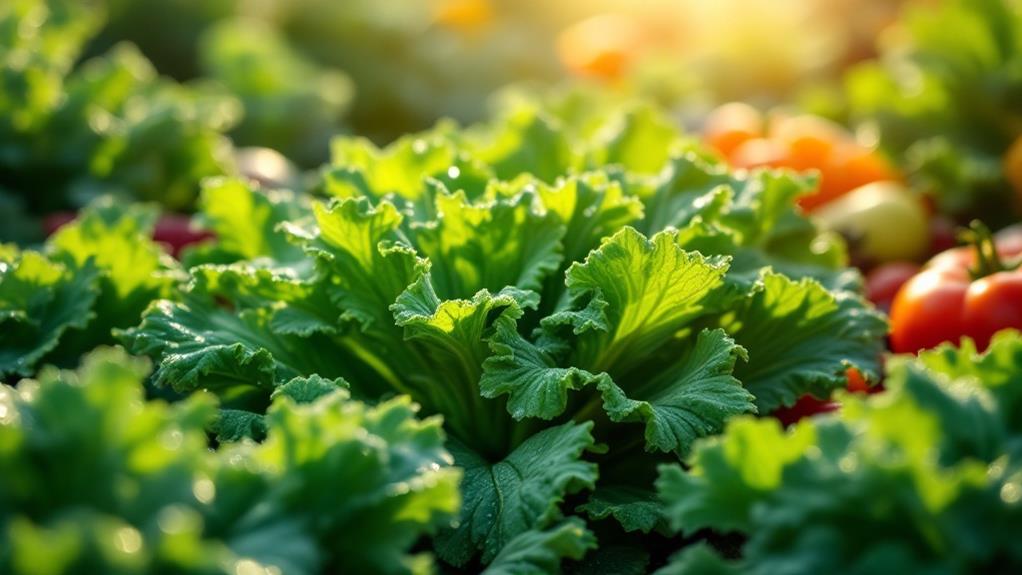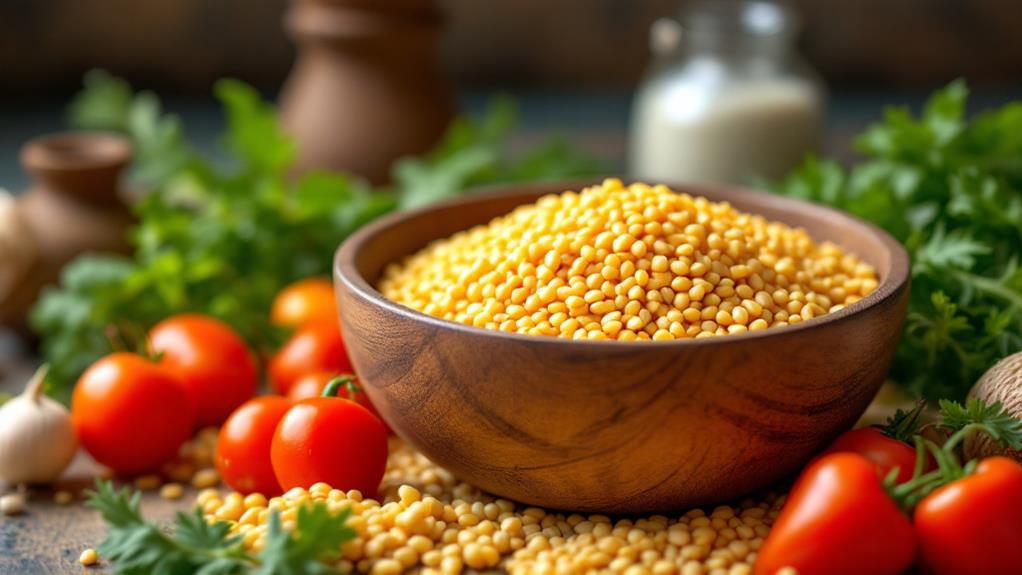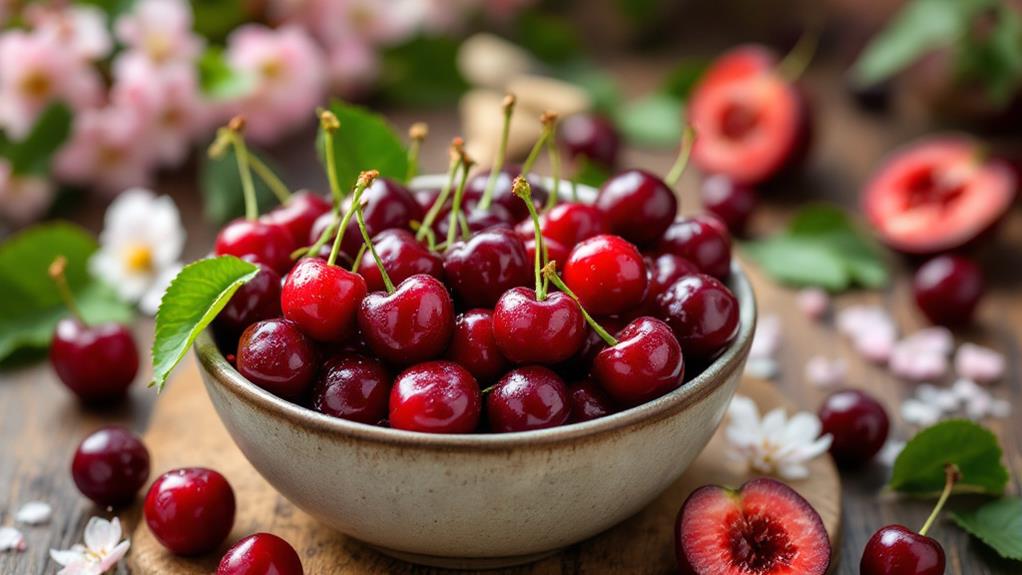A Guide to Rambutan Fruit: Health Benefits and How to Enjoy It
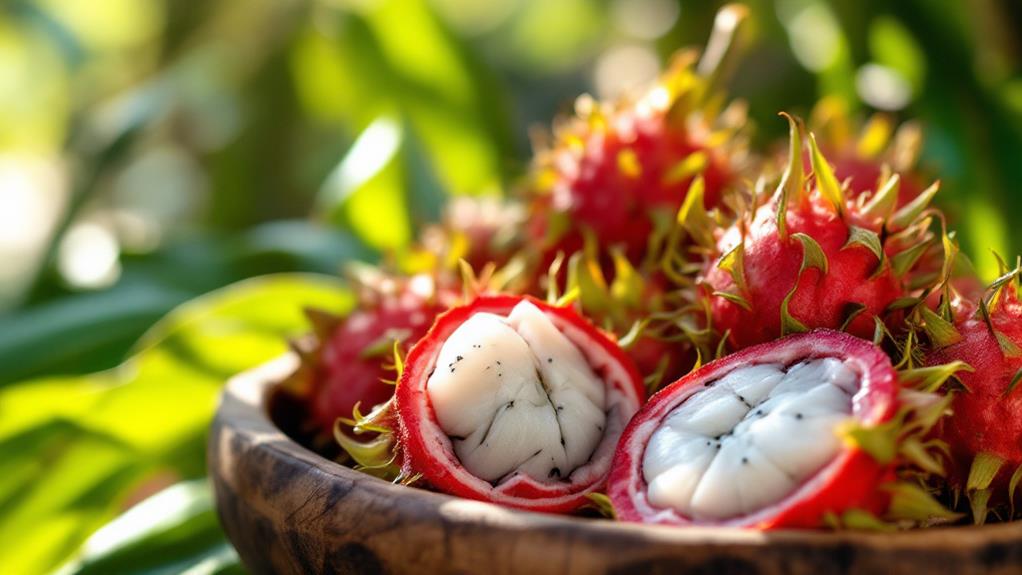
Rambutan is an exotic fruit that'll add a burst of tropical flavor to your diet. It's native to Southeast Asia and easy to spot with its striking red, spiky skin. Inside, you'll find juicy flesh similar to lychee that's rich in vitamin C, antioxidants, and fiber, all supporting immune and digestive health. Eating it fresh is delightful, but you can toss it into salads, smoothies or even curries for a sweet twist. It's a guilt-free snack with just 68 calories per 100 grams. Plunge deeper and uncover how to enjoy its subtle sweetness in creative ways.
Understanding Rambutan Fruit
Rambutan fruit is a fascinating tropical delight that you should know about. Native to Southeast Asia, this tropical fruit is well-known for its unique appearance, with a bright red, spiky exterior. Once you peel away the skin, you're greeted with sweet, juicy flesh that resembles the texture of lychee. Encased within is a creamy white interior surrounding a central seed.
Nutritionally, rambutan is a powerhouse, especially rich in vitamin C, providing between 21.5 to 69.1 mg per 100 grams. This nutrient is essential for immune function and plays a significant role in antioxidant defense, helping your body fight off free radicals. By incorporating rambutan into your diet, you can enjoy these health benefits while savoring its delightful taste.
Rambutan's culinary uses are as varied as its flavors. You can enjoy it fresh or add it to salads and smoothies for a burst of sweetness and acidity. Its unique taste also complements savory dishes, enhancing their flavors with its tropical sweetness. So next time you're exploring tropical fruits, don't miss the chance to enjoy rambutan's nutrition and deliciousness.
Growing and Cultivating Rambutan
Growing and cultivating rambutan can be a rewarding endeavor if you're in a suitable tropical climate. Rambutan trees (Nephelium lappaceum L.) thrive under conditions of high humidity and require well-drained soil to flourish. These trees can grow up to 80 feet tall, making them a striking enhancement to any tropical garden. If you're considering planting rambutan, keep in mind that they are frost sensitive and cannot tolerate temperatures below 50°F (10°C), so protection in cooler climates is vital.
Typically, rambutan trees start bearing fruit 5-6 years after planting. Once established, they have a fruiting cycle approximately every 3 months. The fruit is ready for harvest when the skin turns bright red or yellow, signaling ripeness. Careful handling is significant during harvesting and transport to prevent bruising.
You can propagate rambutan trees from seeds, but this is a slow process. Most commercial cultivation utilizes grafting, which speeds up fruit production and guarantees desirable traits. Regardless of whether you choose seed propagation or grafting, providing the right conditions will help you enjoy a bountiful rambutan harvest. With patience and care, you'll soon be savoring these delicious tropical fruits straight from your garden.
Flavor and Culinary Uses
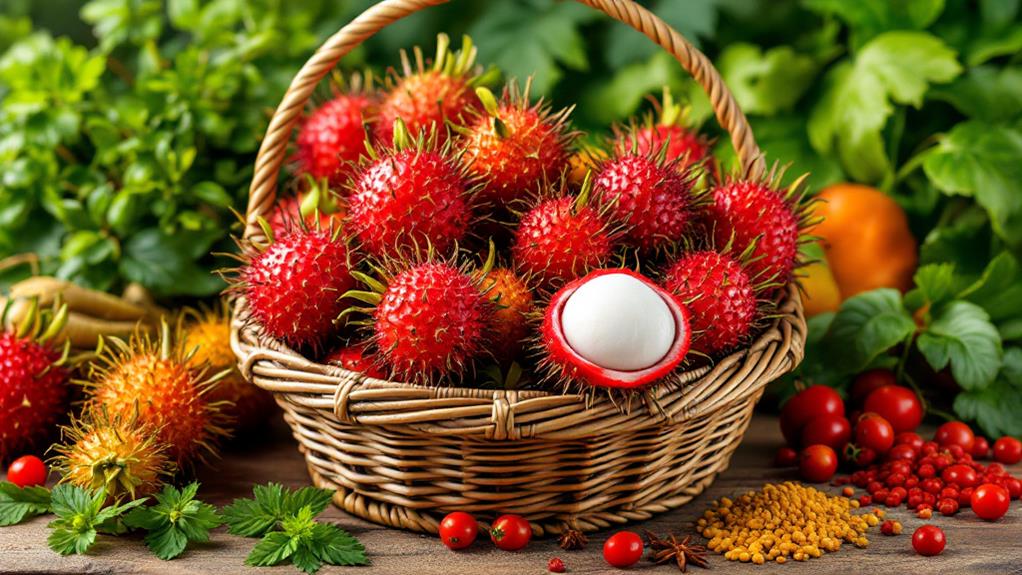
Once you've successfully grown your rambutan tree and are ready to enjoy its fruit, you'll find its flavor to be a delightful surprise. Rambutan fruit boasts a sweet, juicy flesh with a taste often compared to grapes. This unique flavor makes it a fantastic enhancement to fruit salads and desserts, bringing an exotic twist to your culinary creations. When selecting ripe rambutans, look for bright red or yellow skin, as these indicate the fruit is at its peak flavor. Avoid those with green skin, as they tend to be underripe and less flavorful.
Enjoy rambutans fresh by carefully peeling the leathery outer skin to access the delicious, grape-like flesh inside. The fruit's versatility extends beyond fresh consumption; it shines in smoothies, adding a naturally sweet flavor. You can also make jams that capture the essence of this tropical delight. For a savory twist, try incorporating rambutan into curries for a surprising taste contrast. If fresh fruit isn't available, canned rambutan preserved in syrup offers a convenient alternative. Simply rinse them to reduce added sugars before using them in recipes or enjoying as a ready-to-eat snack.
Nutritional Highlights
Packed with nutritional benefits, rambutan is a low-calorie fruit that fits well into a weight management plan. With just 68 calories per 100 grams, it's a guilt-free enhancement to your diet. As a tropical fruit, rambutan is not just about low calories; it's also rich in vitamin C. You'll find between 21.5 and 69.1 mg of vitamin C per 100 grams, supporting your immune function and skin health. This makes it a fantastic choice for elevating your body's defenses and keeping your skin radiant.
Rambutan also contributes to digestive health thanks to its dietary fiber content, ranging from 1.3 to 2 grams per 100 grams. Fiber promotes regularity and helps keep your digestive system running smoothly. Moreover, rambutan is a good source of copper, providing about 20% of your daily copper needs per 100 grams. Copper is crucial for energy production and further supports immune health.
The antioxidants in rambutan, including polyphenols and flavonoids, are particularly beneficial. These compounds help combat oxidative stress, reducing the risk of chronic diseases. Enjoy rambutan as a delicious and nutritious part of your tropical fruit selection, offering you an enhancement in health and flavor.
Health Benefits Overview
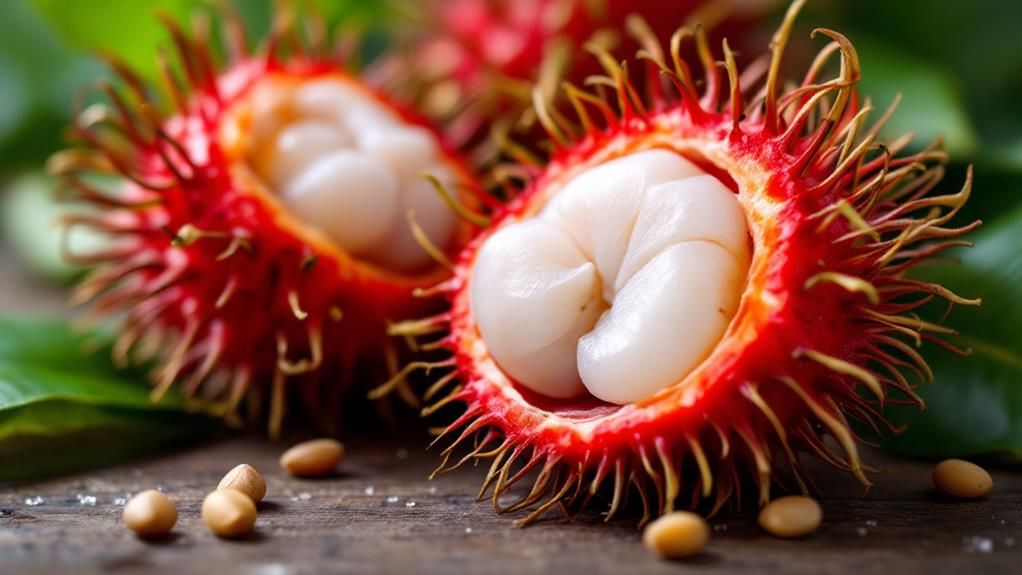
When you reach for a rambutan, you're not just indulging in a sweet tropical treat; you're also embracing a host of health benefits. Packed with vitamin C, this lively tropical fruit supports your immune function and skin health. Each 100 g serving provides between 21.5 to 69.1 mg of vitamin C, meeting 24-77% of your daily needs.
Rambutan is also a great source of dietary fiber, with 1.3 to 2 g per 100 g, which promotes digestive health. It aids in cholesterol management and may lower the risk of colon cancer and type 2 diabetes. Plus, its low calorie content—just 68 calories per 100 g—makes it a smart choice for weight management without sacrificing flavor.
The antioxidants in rambutan, such as polyphenols and flavonoids, help combat oxidative stress and inflammation. These compounds may reduce the risk of chronic diseases, including certain cancers. While the peel and seeds aren't typically consumed, they've shown potential in studies for supplementary health benefits, like lowering cholesterol and enhancing insulin sensitivity.
Incorporating rambutan into your diet can be a delicious way to enhance general health while savoring a delightful tropical experience.
Potential Risks and Precautions
While rambutan offers numerous health benefits, it's important to be aware of potential risks associated with its consumption. If you have a known fruit allergy, be cautious, as rambutan can trigger allergic reactions ranging from mild skin rashes to severe gastrointestinal distress. Always introduce this fruit into your diet gradually and monitor for any adverse symptoms.
The seeds of rambutan are inedible and can be harmful. Consuming them raw may lead to narcotic effects like sleepiness or even coma. Proper handling is vital; avoid eating the seeds and make sure you prepare the fruit carefully. The peel and seeds contain toxic compounds, and roasting is the only method known to reduce seed toxicity.
Additionally, consuming more than 100 grams of rambutan might lead to digestive discomfort or other gastrointestinal issues due to its high fiber content. Moderation is key to enjoying this fruit without adverse effects.
If you prefer canned rambutan, be mindful of added sugars. These products can contain high sugar levels, so check the labels and rinse the fruit to reduce sugar content before eating. Taking these precautions will help you enjoy rambutan safely and deliciously.
Comparing Rambutan and Lychee
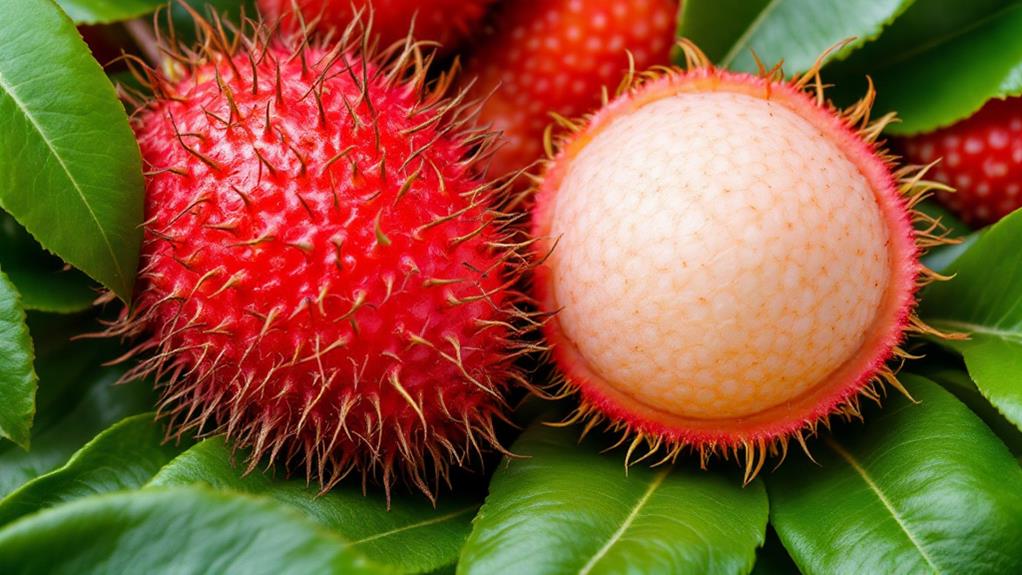
Rambutan and lychee, both enchanting tropical fruits, offer a delightful taste experience but differ in several notable ways. When making a comparison, you'll notice that rambutan is generally larger, measuring around 2-4 inches, whereas lychee is more petite, at 1-2 inches. Rambutan's exterior is distinctive with its long, hairy spines, while lychee boasts a smooth, bumpy, leathery skin turning from green to red or pink when ripe. Both fruits have juicy flesh and a sweet flavor, but rambutan's taste can range from sweet to slightly sour, depending on ripeness. In contrast, lychee consistently delivers a mainly sweet flavor.
In terms of nutritional profiles, rambutan edges out lychee with higher fiber content, offering about 1.3-2 grams per 100 grams compared to lychee's 1.1 grams. This fiber content contributes to the health benefits of rambutan. Despite sharing a similar texture, rambutan's flesh tends to be creamier and more gelatinous, while lychee has a firmer consistency. When savoring these tropical fruits, you'll appreciate the unique characteristics each one brings to the table. Regardless of being drawn to rambutan's exotic appearance or lychee's consistent sweetness, both fruits are nutritious delights worth exploring.
Ways to Enjoy Rambutan
Investigating ways to enjoy rambutan can often lead to delightful culinary revelations. This exotic fruit is a sweet tropical snack that's perfect for savoring fresh. Peel the skin carefully to reveal the juicy, edible white flesh. Fresh rambutan has a flavor profile similar to lychee, and its juicy texture is reminiscent of grapes. To optimize its nutritional benefits, enjoy it within a few days of purchase.
Incorporate rambutan's unique sweetness into your fruit salad for a revitalizing twist. Its flavorful inclusion improves the taste of smoothies and desserts, offering a tropical flair. Simply add fresh or frozen rambutan to your favorite recipes for a burst of natural sweetness that pairs well with other fruits.
Rambutan also shines in savory dishes. Its sweetness can balance the heat in spicy curries, creating a delightful contrast. Consider using it in sauces or as a garnish to uplift your culinary creations. You can even freeze rambutan to craft cool, invigorating cocktails perfect for warm weather.
Whether you eat it fresh or blend it into creative dishes, rambutan offers endless possibilities to investigate its delicious and nutritious potential.
Recipes Featuring Rambutan
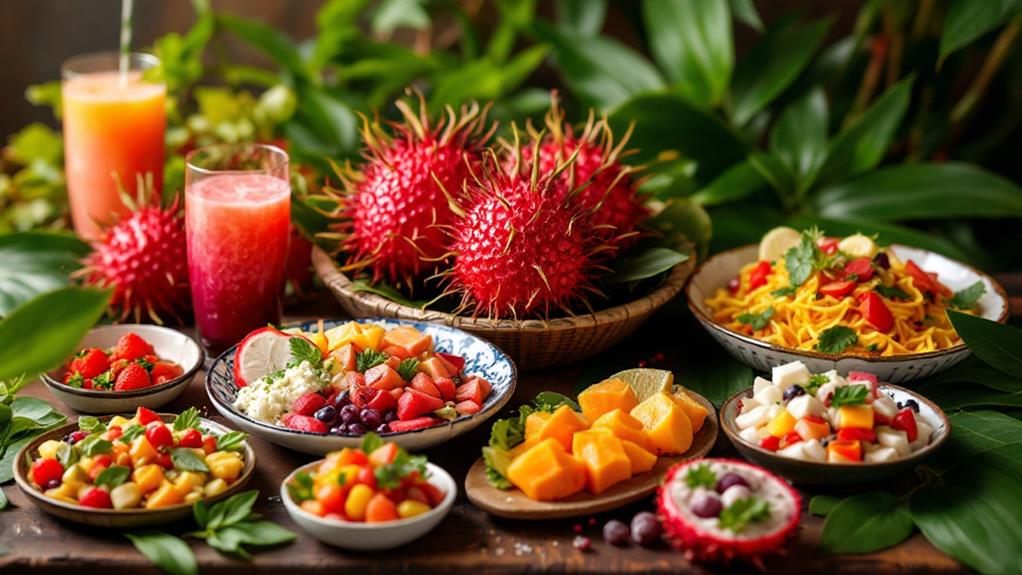
Savoring rambutan can be an exciting culinary adventure, and exploring recipes that feature this exotic fruit is a great way to enhance your cooking repertoire. Fresh rambutans are a sweet tropical snack, perfect for fruit salads and desserts. Their lychee-like flavor adds an exotic twist that's sure to impress. Here are some delicious ways to enjoy rambutan:
- Rambutan Smoothies: Blend fresh rambutans with yogurt, ice, and a splash of lime juice. This invigorating drink not only tastes great but also offers health benefits by incorporating the fruit's natural sweetness into your diet.
- Rambutan Jam: Cook the fruit's flesh with sugar and lemon juice until thickened. This unique spread is perfect for toast or as a topping for desserts, providing a delightful balance of sweetness and tang.
- Savory Dishes: Incorporate diced rambutan into curries or salads. Its burst of sweetness complements spicy flavors, enhancing the dish's comprehensive taste profile.
- Cocktails: Freeze rambutan to create cool, fruity garnishes for drinks like mojitos or tropical punches. The frozen fruit adds a revitalizing element to your favorite cocktails.
These recipes are a fantastic way to enjoy the health benefits of this tropical delight.
Storing and Buying Tips
When you're buying rambutans, look for bright red or yellow skins without blemishes, as this indicates ripeness and quality. Fresh rambutans should feel slightly firm to the touch. Avoid overripe fruits, which are typically overly soft and may spoil quickly. If you're shopping outside Southeast Asia, don't worry. You can find rambutans in Asian grocery stores or online. Keep in mind that their peak season is winter, around December and January, when they're most plentiful.
To maintain freshness, store unpeeled rambutans in a cool, dry place. For longer storage, refrigerate them, and they'll last several days. This keeps them fresh and ready to enjoy whenever you want. If you're opting for canned rambutan, remember to check labels for added sugars. Canned options often come in syrup, which can increase sugar content. Rinse them before consuming to reduce this.

